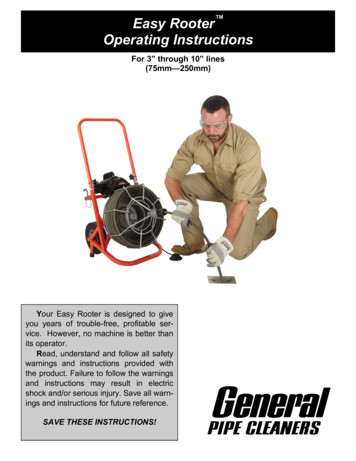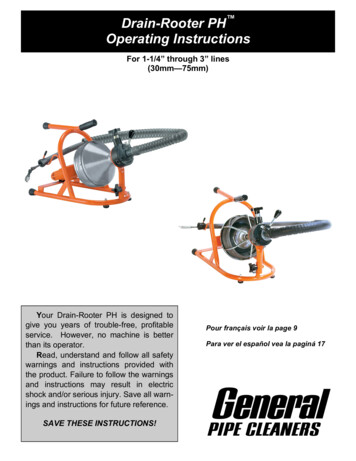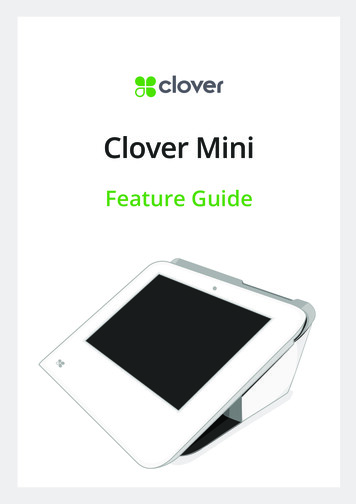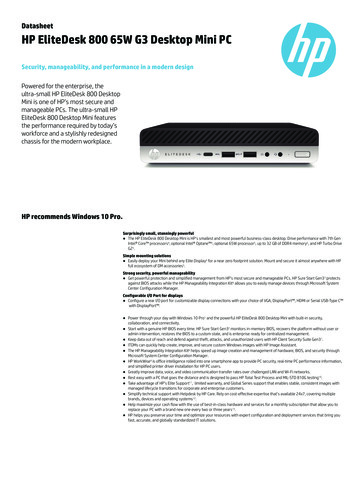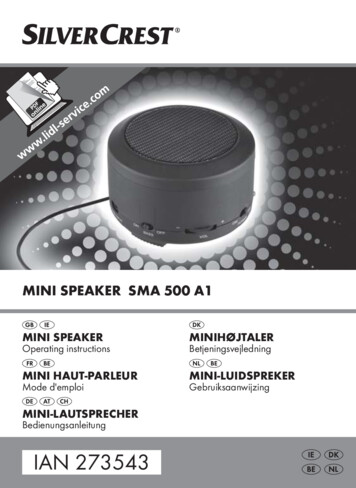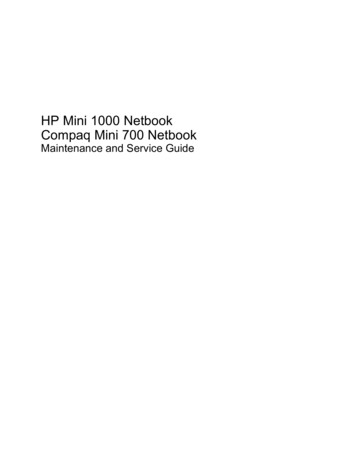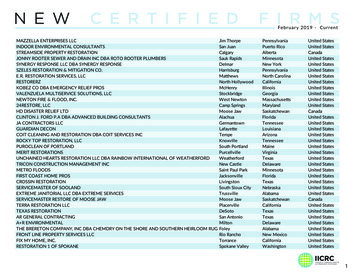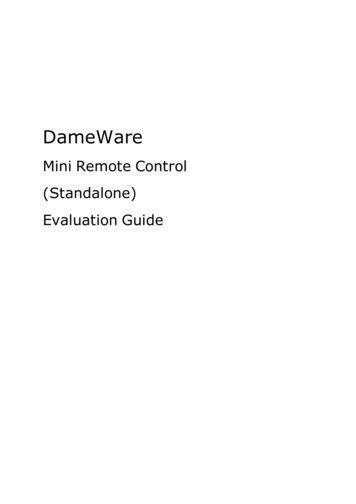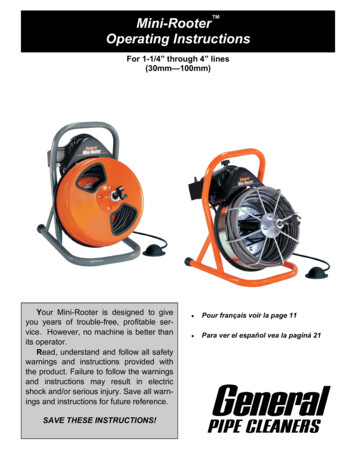
Transcription
Mini-Rooter Operating InstructionsFor 1-1/4” through 4” lines(30mm—100mm)Your Mini-Rooter is designed to giveyou years of trouble-free, profitable service. However, no machine is better thanits operator.Read, understand and follow all safetywarnings and instructions provided withthe product. Failure to follow the warningsand instructions may result in electricshock and/or serious injury. Save all warnings and instructions for future reference.SAVE THESE INSTRUCTIONS!Pour français voir la page 11Para ver el español vea la paginá 21
Mini-Rooter Electric shock resulting indeath can occur if you plugthis machine into an improperly wired outlet. If the groundwire is electrified, you can beelectrocuted by just touchingthe machine, even when thepower switch is off. A groundfault circuit interrupter will not protect you in this situation. Use aUL approved tester to determineif the outlet is safe.WARNING! Read and understand allinstructions. Failure to follow all instructionslisted below may result in electric shock, fireand/or serious personal injury. Replacementmanuals are available upon request at nocharge, or may be downloaded from our website, www.drainbrain.com. Instructional videosare available for download on our website, andmay be ordered. If you have any questions orproblems, please call General’s customerservice department at 412-771-6300.Do not operate power tools inexplosive atmospheres, suchas in the presence of flammable liquids, gases, or dust.Power tools create sparks whichmay ignite dust or fumes.SAVE THESE INSTRUCTIONS!These instructions are intended tofamiliarize all personnel with the safeoperation and maintenanceprocedures for the Mini-Rooter.Only wear leather gloves.Never use any other type ofglove, such as cloth, rubber, orcoated gloves. Never grasp arotating cable with a rag.These items could becomewrapped around the cable andcause serious injury.SAFETY SYMBOLSThis is the safety alert symbol. It isused to alert you to potential personalinjury hazards. Obey all safety messages that follow this symbol to avoidpossible injury or death.Always wear safety glassesand rubber soled, non-slipshoes. Use of this safety equipment may prevent serious injury.DANGER indicates a hazard with a high level of riskwhich, if not avoided, will result in death or serious injury.Never operate machine withbelt guard removed. Fingerscan get caught between belt andpulley.WARNING indicates a hazard with a medium level of riskwhich, if not avoided, could result in death or serious injury.Do not overstress cables.Overstressing cables may causetwisting, kinking, or breaking ofthe cable and may result in serious injury.CAUTION indicates a hazard with a low level of risk which,if not avoided, will result in minor or moderate injury.2
Mini-Rooter Personal SafetyGENERAL SAFETY RULES1. Stay alert, watch what you are doing and use common sensewhen operating a power tool. Do not use tool while tired orunder the influence of drugs, alcohol, or medication. A moment of inattention while operating power tools may result in serious personal injury.WARNINGRead and understand all instructions. Failure to follow all instructions listed below may result in electric shock, fire, and/orserious injury.2. Dress properly. Do not wear loose clothing or jewelry. Contain long hair. Keep your hair, clothing, and gloves awayfrom moving parts. Loose clothes, jewelry, or long hair can becaught in moving parts.SAVE THESE INSTRUCTIONS!Work Area1. Keep work area clean and well lit. Cluttered benches and darkareas invite accidents.3. Avoid accidental starting. Be sure switch is off before plugging in. Carrying tools with your finger on the switch or plugging intools that have the switch on invites accidents.2. Do not operate power tools in explosive atmospheres, suchas in the presence of flammable liquids, gases, or dust. Powertools create sparks which may ignite the dust or fumes.4. Remove adjusting keys or switches before turning the toolon. A wrench or key that is left attached to a rotating part of thetool may result in personal injury.3. Keep bystanders, children, and visitors away while operatinga power tool. Distractions can cause you to lose control.5. Do not overreach. Keep proper footing and balance at alltimes. Proper footing and balance enables better control of thetool in unexpected situations.Electrical Safety1. Grounded tools must be plugged into an outlet, properly installed and grounded in accordance with all codes and ordinances. Never remove the grounding prong or modify theplug in any way. Do not use any adapter plugs. Check with aqualified electrician if you are in doubt as to whether the outlet is properly grounded. If the tool should electrically malfunction or break down, grounding provides a low resistance path tocarry electricity away from the user.6. Use safety equipment. Always wear eye protection. Dustmask, non-skid safety shoes, hard hat, or hearing protection mustbe used for appropriate conditions.Tool Use and Care1. Use clamps or other practical way to secure and support theworkpiece to a stable platform. Holding the work by hand oragainst your body is unstable and may lead to loss of control.2. Avoid body contact with grounded surfaces such as pipes,radiators, ranges and refrigerators. There is an increased risk ofelectric shock if your body is grounded.2. Do not force tool. Use the correct tool for your application.The correct tool will do the job better and safer at the rate forwhich it is designed.3. Do not expose power tools to rain or wet conditions. Waterentering a power tool will increase the risk of electric shock.3. Do not use tool if switch does not turn it on or off. Any toolthat cannot be controlled with the switch is dangerous and mustbe repaired.4. Do not abuse the cord. Never use the cord to carry the toolsor pull the plug from an outlet. Keep cord away from heat, oil,sharp edges or moving parts. Replace damaged cords immediately. Damaged cords increase the risk of electric shock.4. Disconnect the plug from the power source before makingany adjustments, changing accessories, or storing the tool.Such preventative safety measures reduce the risk of starting thetool accidentally.5. When operating a power tool outside use an outdoor extension cord marked “W-A” or “W”. These cords are rated for outdoor use and reduce the risk of electric shock.5. Store idle tools out of reach of children and other untrainedpersons. Tools are dangerous in the hands of untrained users.6. Test the Ground Fault Circuit Interrupter (GFCI) provided withthe power cord to insure it is operating correctly before operating machine. Machine must have a properly functioning groundfault circuit interrupter on the power cord. GFCI reduces the risk ofelectric shock.6. Maintain tools with care. Keep cutting tools sharp and clean.Properly maintained tools, with sharp cutting edges are less likelyto bind and are easier to control.7. Check for misalignment or binding of moving parts, breakageof parts, and any other condition that may affect the tool‟soperation. If damaged, have the tool serviced before using.Many accidents are caused by poorly maintained tools.7. Extension cords are not recommended unless they areplugged into a Ground Fault Circuit Interrupter (GFCI) foundin circuit boxes or outlet receptacles. The GFCI on the machinepower cord will not prevent electric shock from the extensioncords.8. Only use accessories that are recommended by the manufacturer for your model. Accessories that may be suitable for onetool may become hazardous when used on another tool.8. Only use proper three-wire extension cords in good conditionwhich have three-prong grounding plugs and three-pole receptacles which accept the tool‟s plug. Use of damaged, inferior, or other extension cords will not ground the tool. Increasesthe risk of electric shock and bodily injury or death.Service1. Tool service must be performed only by qualified repair personnel. Service or maintenance performed by unqualified repairpersonnel could result in risk of injury.9. Keep all electric connections dry and off the ground. Reducesthe risk of electric shock.2. When servicing a tool, use only identical replacement parts.Follow instructions in the Maintenance section of this manual. Use of unauthorized parts or failure to follow MaintenanceInstructions may create a risk of electric shock or injury.10. DO NOT touch plugs or tools with wet hands. Reduces the riskof electric shock.3
Mini-Rooter SPECIFIC SAFETY RULESGround Fault Circuit Interrupter (GFCI)Your machine is equipped with a ground fault circuit interrupter, whichprotects you against shock if a short circuit should occur. Check thatreceptacle is properly grounded. Test the GFCI before each use.1. Plug into 120-volt receptacle.2. Push test button. Indicator light will go out and power to machineshould cut off.3. If light does not go out when test button is pushed, DO NOT USETHE MACHINE until proper repairs can be made.4. To restore power after test, push reset button. With the reset button depressed, if the machine doesn't start, stops while running, orif the operator experiences a mild shock, DO NOT USE THE MACHINE! Tag the machine out of service and take it to a motorrepair center or return it to the factory for repairs.This is the safety alert symbol. It is used to alertyou to potential personal injury hazards. Obey allsafety messages that follow this symbol to avoidpossible injury or death.Electric shock resulting in death can occur if youplug this machine into an improperly wired outlet. Ifthe ground wire is electrified, you can be electrocutedby just touching the machine, even when the powerswitch is off. A ground fault circuit interrupter will notprotect you in this situation. Use a UL approved tester todetermine if the outlet is safe.Do not overstress cables. Overstressing cables maycause twisting, kinking, or breaking of the cable and mayresult in serious injury.THE SECTION OF CORD BETWEEN THE WALL PLUGAND THE GFCI IS NOT IN THE PROTECTED CIRCUIT.1. Only wear leather gloves. Never use any other type of glove,such as cloth, rubber, or coated gloves. Never grasp a rotatingcable with a rag. These items could become wrapped around thecable and cause serious injury.FEATURES2. Never operate machine with belt guard removed. Fingers canget caught between belt and pulley.Motor SwitchMini-Rooter Closed Drum3. Do not overstress cables. Keep leather-gloved hand on the cable for control when machine is running. Overstressing cablesbecause of an obstruction may cause twisting, kinking, or breakingof the cable and may result in serious injury.Belt GuardV-Belt4. Place the machine at a distance not greater than two feet fromthe opening. Greater distances can result in cable twisting orkinking.Carrying HandleFemaleConnectorCutterDrum5. Machine is designed for ONE-PERSON operation. Operatormust control foot switch and cable.Cable6. Do not operate machine in reverse (REV). Operating machinein reverse can result in cable damage and is used only to backcutting tool out of an obstruction.Foot PedalNOTE: Do not operate machine if warning labels on the switch boxand power cord are missing or illegible.7. Keep hands away from rotating drum. Do not reach into drumunless machine is unplugged. Hand may be caught in the movingparts resulting in serious injury.8. Be careful when cleaning drains where cleaning chemicalshave been used. Avoid direct contact with skin and eyes. Draincleaning chemicals can cause serious burns as well as damagethe cable.Mini-Rooter Open DrumMotor Switch9. Do not operate machine if operator or machine is standing inwater. Will increase risk of electrical shock.Belt Guard10. Wear safety glasses and rubber soled, non-slip shoes. Use ofthis safety equipment may prevent serious injury.V-Belt11. Before starting each job, check that the cable in the drum isnot broken or kinked, by pulling the cable out and checkingfor wear or breakage. Always replace worn out (kinked or broken) cables with genuine GENERAL replacement cables.Carrying HandleFemaleConnectorCutterCage12. Only use this tool in the application for which it was designed. Follow the instructions on the proper use of the machine. Other uses or modifying the drain cleaner for other applications may increase risk of injury.CableFoot PedalNOTE: Do not operate machine if warning labels on the switch boxand power cord are missing or illegible.4
Mini-Rooter Cable Application Chart (Table sSizeCapacity3" to 4" Roof Stacks and Small Floor Drains75 ft.(No roots)3/8"2" to 3" Roof Stacks, Laundry Lines & Small75 ft.Drains*5/16" 1-1/2" Sinks, Basins & Small Drains50 ft.to 2"1-1/4" Small Lines, Tubs & Shower Drains*1/4"50 ft.to 2"*The 1/4‖ and 5/16‖ diameter cables are for use with the J-Drum andDual Drum.1. Begin by pulling the cable from the drum/cage and sliding it intothe drain as far as it will go.2. Move the motor switch to the forward position.3. With both hands (wearing leather gloves) on the cable, depressthe air foot pedal to start machine.4. Feed the cable into the line and against the obstruction with a firm,even pressure. Adjust the feeding rate to the resistance met. Donot force the cable – let the cutter do the work. The job won’t getdone any faster and you could damage the cable.DO NOT USE TOO MUCH FORCE –LET THE CUTTER DO THE WORK.5. Don't leave too much slack in the cable since this will cause whipping. If the cable starts to bend or build up too much twist, releasepressure on the foot pedal and rotate the drum in the oppositedirection to relieve the twist on the cable. Push any excess cableback into the drum and then continue.Cutter Application Chart (Table 2)CutterCat. #Typical ApplicationsCutters for 3/8” and ‖ Side CutterBladeAHStarting tool, ideal for cuttingand scraping.BGStarting tool, to remove looseobjects.DO NOT ALLOW TOO MUCH SLACK IN THE CABLEBETWEEN MACHINE AND DRAIN OPENING SINCETHIS CAN CAUSE CABLE WHIPPING.6. If you're having trouble getting around tight bends, try putting themachine in reverse while applying steady pressure. (If usingPower Cable Feed, putting motor in reverse will cause the feedcontrol lever to operate opposite of normal.) Note: If your machineis equipped with a momentary contact reverse switch, you musthold the switch in position when operating the machine in reverse.1-1/2UC Finishing tool, works well ingrease stoppages.2SCBFinishing tool, for scrapinginside edges of pipe.Note: There are no fixed rules for what cutter to use. If one tool doesnot take care of a stoppage, simply try another.OPERATING INSTRUCTIONSSet-UpMAKE SURE THE MOTOR SWITCH IS INTHE „OFF‟ POSITION!1. Place machine within approximatelytwo feet (.6m) of drain opening. If youcan’t place the machine this close tothe drain opening, run the cablethrough a metal guide tube to preventcable whipping.Don't run motor in reverse for more than a few seconds at atime as this could cause tangling in the drum or kinking.7. If you still can't get around the bend, you're probably using toolarge a cable. Switch to a 3/8" diameter cable, or even a smallerone if necessary. (See Cable Application Chart—Table 1)2. Position the foot pedal for easy accessibility. The machine is designed forone-person operation. Be sure youcan quickly remove your foot from thepedal in an emergency.8. When the cable reaches the stoppage, allow the cable to progressforward slowly, chewing into the stoppage as it goes. This slowforward movement will reduce stress on the cable while doing amore thorough cleaning job. A back and forth action often worksbest.3. Be sure the motor switch is in the off position.4. Select the proper cutting tool (See Cutter Application Chart—Table2). A good tool to start with is the Arrow Head or Boring Gimlet.After the line is opened, follow with larger blades, which scrapethe inside edges of the pipe, assuring a real cleaning job.Hint: It's often helpful to have a small stream of water running in theline to wash the cuttings away while the machine is in operation andafter.5. Insert the cutter into the female connector at the end of the 3/8" or1/2" cable and tighten the connecting screw and lock washer firmlyin place.5
Mini-Rooter 9. Be careful not to let the cutter get caught in the stoppage as youwork through it. This can cause kinking and breaking of the cable.When you feel the cable starting to twist in your hands, stop themachine and pull back on the cable. This will free the cutter fromthe obstruction. Then allow the cable to move forward slowly intothe stoppage. Remember, no cutting takes place when the bladesstop turning.5. Tighten the knob at the top of the Power Cable Feed so that thefeed roller presses against the cable. Be sure not to over tightensince this could cause excess cable wear. Note: The Power CableFeed is designed for use with 3/8‖ and 1/2‖ cables only.10. After the line has been opened, retract the cable. Make sure themotor switch is in the forward position. This is important to prevent the cable from tangling in the drum or in the line.6. The feed lever controls the feeding rate and direction of the cable.Move the lever down to feed the cable out of the drum. The furtherthe lever is moved downward, the faster the cable will feed out.Move the lever up to retract the cable into the drum. When thelever is in the middle (neutral) position, the cable will spin in place.7. Move the motor switch to the forward position. Then, with agloved hand on the guide tube, depress the air foot pedal to startmachine.8. Feed the cable into the line and against the obstruction with a firm,even pressure. Adjust the feeding rate to the resistance met. Donot force the cable – let the cutter do the work. The job won’t getdone any faster and you could damage the cable.Note: In operation, use the least pressure possible to get the jobdone in order to minimize wear on the feed and cable.DO NOT USE REVERSE TO PULL THE CABLE OUTOF THE DRAIN. RUNNING MACHINE IN REVERSECAN CAUSE THE CABLE TO TANGLE IN THE DRUM.11. When the cutter is near the drain opening, take your foot off thepedal to stop drum rotation. Never retract the cutter from drainwhile cable is rotating. The cable could whip and cause seriousinjury.DO NOT USE TOO MUCH FORCE –LET THE CUTTER DO THE WORK.POWER CABLE FEED(Optional. Cat. # PO-MR)The variable speed Power Cable Feed is designed for use with 3/8‖and 1/2‖ cables. If the feed was purchased separately, see ―How toInstall Power Cable Feed.‖9. Don't leave too much slack in the cable since this will cause whipping. If the cable starts to bend or build up too much twist, releasepressure on the foot pedal and rotate the drum in the oppositedirection to relieve the twist on the cable. Push any excess cableback into the drum and then continue.1. Be sure you have read and understand the instructions formanual feed before using thePower Cable Feed. Misuse of thefeed can result in severe damageto the cable.2. Put the feed control handle in theneutral position. Then, loosen thefeed pressure knob and pull threefeet of cable from the drum/cage.3. Slide the guide tube (Cat. # MRGT) over the cable and snap the tube into place on the feed spout.(Be sure to remove the cutter and connecting screw from the female connector first. Reattach desired cutter to cable after guidetube is attached to feed.)4. Place machine within approximately two feet of drain opening. Besure the Mini-Rooter Guide Tube (MR-GT) is in place. If you can’tplace the machine this close to the drain opening, run the cablethrough the optional Guide Tube Extension (GTE) or a metal guidetube to prevent cable whipping.Feed Pressure KnobDO NOT ALLOW TOO MUCH SLACK IN THE CABLEBETWEEN MACHINE AND DRAIN OPENING SINCETHIS CAN CAUSE CABLE WHIPPING.10. When the cable reaches stoppage, put the feed in neutral. Thenallow the cable to progress forward slowly, chewing into stoppageas it goes. This slow movement will reduce stress on cable whiledoing a more thorough cleaning job. A back and forth motion oftenworks best.11. Move the feed lever to the reverse position (upward) to retract thecable. If more pulling power is required, the motor may be put inreverse and the feed lever moved downward to forward position.12. After the line has been opened, retract the cable by moving thefeed lever up. Make sure the motor switch is in the forward position. This is important to prevent the cable from tangling in thedrum or in the line.Feed Control LeverDO NOT RUN MOTOR IN REVERSE FOR MORE THAN AFEW SECONDS AT A TIME SINCE THIS COULD CAUSETHE CABLE TO KINK OR TANGLE IN THE DRUM.Reverse13. When the cutter is near the drain opening, take your foot off thepedal to stop drum rotation. Never retract the cutter from drainwhile cable is rotating. The cable could whip and cause seriousinjury.NeutralForward6
Mini-Rooter SPECIAL OPERATIONSHOW TO INSTALL 3/8" AND 1/2" CABLES IN DRUMIF CABLE GETS CAUGHT IN LINEDISCONNECT MACHINE FROM POWER SOURCEBEFORE INSTALLING CABLES OR DRUMS!The motor can be reversed to free cable if it gets caught in the line.Use the following procedure:1. Move toggle switch on motor to reverse position.2. Wearing leather gloves, pull on cable while the drum is turning inreverse.1. There is a socket inside the drum for the back end of the cable.Rotate the drum so that the socket is at the bottom.2. Position the distributor tube so that it is pointing downward.3. Push the cable into the drum until there isa full loop in the drum.4. Reach into the drum, grasp the cable,and bend it into the socket.5. Remove V-Belt and rotate the drum tothe right, or clockwise, with one handwhile pushing cable into the drum withthe other hand.DO NOT RUN MOTOR IN REVERSE FOR MORE THAN AFEW SECONDS AT A TIME SINCE THIS COULD CAUSETHE CABLE TO KINK OR TANGLE IN THE DRUM.3. When the cable is freed, slide excess cable back into drum.4. Move the toggle switch to the forward position again, and continueat Step 3 of the Operating Instructions.Note: The cable should lay in the drum ina clockwise direction.IF CABLE TANGLES IN DRUMThis is almost always caused by using too much pressure when feeding the cable, or by feeding the cable while running the machine inreverse. To untangle, rotate drum in opposite direction. This will usually get the cable to lie in the drum properlyIf cable has become badly tangled, which shouldn’t happen whenmachine is used properly, it can be straightened out by removing thedistributor tube from the drum. To do this:HOW TO USE J-DRUM(Optional. Cat. No. MR-250)The J-Drum holds 50 feet of 1/4‖ or 5/16‖cable to be used when you need to clearsmaller 1-1/4‖ to 2‖ lines. These cables have abasin plug head that can be spun throughmost strainers. (See Cable ApplicationChart—Table 1)DISCONNECT MACHINE FROM POWER SOURCEBEFORE INSTALLING CABLES OR DRUMS!1. Loosen the four bolts that hold the distributor tube cone on thefront of the drum.2. Pull the cone and distributor tube forward, then pull the tangledportion of the cable out of the drum.3. After the cable has been straightened out, slide the distributor tubeand cone back along the cable until it can be repositioned andbolted to the front of the drum.4. Then, push the excess cable back into the drum.DISCONNECT MACHINE FROM POWER SOURCEBEFORE INSTALLING CABLES OR DRUMS!1. To install cable, open chuck jaws fully so that cable will passthrough easily.2. Slide the back end of the cable (opposite to the end with basinhead) through spout and into the drum. The cable will be easier toinstall if you bend the last inch of cable at a 45 degree angle.3. When working through difficult stoppages or tight bends, tightenthe chuck to provide more torque and to prevent the cable fromtangling in the drum.4. Clean and lubricate chuck regularly to prevent corrosion.HOW TO REMOVE DRUM FROM MACHINEDISCONNECT MACHINE FROM POWER SOURCEBEFORE INSTALLING CABLES OR DRUMS!HOW TO USE DUAL-DRUM1. Push down on the spring-loaded motorand slide the V-Belt off the back of thedrum.(Optional—Cat #MR-280)The Dual-Drum holds two different diametercables at the same time. Inner and outerdrum compartments protect the cable fromtangling. You can easily switch from 1/4‖ to5/16‖ or 3/8‖ cables without removing eitherone from the drum.2. Reach behind the drum and locate thedrum-retaining latch. Pull the latch torelease the drum shaft, then pull thedrum forward off of the machine.3. To install the drum, simply slide drumonto machine. The latch will lock automatically.DISCONNECT MACHINE FROM POWER SOURCEBEFORE INSTALLING CABLES OR DRUMS!4. Remove the belt guard by loosening retaining knob on top. Position the V-Belt around the drum, then press down on the motorand slip V-belt onto the pulley. Be sure to reattach the belt guard.1. Install 1/4‖ cable into the Dual-Drum by sliding the back end of thecable (opposite to end with basin head) through spout and into theinner drum. The cable will be easier to install if you bend the lastinch of cable at a 45-degree angle.7
Mini-Rooter 3. Fully loosen upper clamp knob on the feed support bracket andsnap the clamp over the Mini-Rooter’s upper frame. Center thefeed over the drum spout and slide the cable through the feedrollers. Then moderately tighten the knob.4. Loosen the two lower clamp cap screws to allow the clamps to fitover the lower frame. Note that the ―short‖ clamp half should beclosest to the floor.5. It may be necessary to loosen and re-adjust the upper tube lengthto get the correct fit. Loosen the two set screws in the upper tubeand slide the assembly to get the best fit.6. When alignment is correct, tighten the lower clamp set screws.Screws should not be fully tightened. Make snug only so that thebracket is able to pivot.7. Fully tighten the upper tube set screws.8. Test the bracket by loosening the knob and swinging the feedassembly outward. It should disengage and swing smoothly.9. Swing the feed assembly back and the clamp should snap into thelocked position. Tighten the knob to secure the feed for operation.Do not attempt to use or transport the unit unless the upper clampknob is tightened.2. Install the 5/16‖ or 3/8‖ cable into the outer drum by sliding theback end of the cable (opposite to the end with the Female connector) through the spout. Reach one hand into the drum throughone of the two ports in the face of the drum and pull the cable endto the left side of the outer drum. Then push another two feet ofcable into the drum while pulling the cable downward to form aloop. The cable should lay in the drum in a clockwise direction.3. Select the appropriate cable for the line you are working on. (SeeCable Application Chart—Table 1) If a 1/4‖ cable is required,reach into the Dual-Drum and pull the cable out of the inner drumand through the spout. If a larger cable is required, slide the 1/4‖cable back though the spout, then reach into the drum and pull the5/16‖ or 3/8‖ cable from the outer drum through the spout.4. Each of the cables can be ―chucked‖ in place to provide moretorque by pressing the knurled knob against the spring and tightening it against the cableNote: Use HE cables only in Dual-Drum—not EM cables.HOW TO INSTALL DOLLY(Optional. Cat. No. MR-W)The dolly makes it easy to transport the Mini-Rooter to and from thejob. Designed especially for the Mini-Rooter, it snaps on and off inseconds and holds the machine securely.To install:MAINTENANCEDISCONNECT MACHINE FROM POWER SOURCEBEFORE PERFORMING MAINTENANCE!DISCONNECT MACHINE FROM POWER SOURCEBEFORE INSTALLING DOLLY!To keep your machine operating smoothly, it is essential that all bearings and distributor tube bushings be lubricated. Oiling moving parts isparticularly important where machine comes in contact with sand, gritand other abrasive material.1. Hold the dolly horizontally above the MiniRooter with the wheels toward the back ofthe machine.2. Tilt the top of the dolly down so the hookson the mid-point of the dolly slip under thetop crossbar of the machine. Then, lowerthe wheels to the ground.3. Step behind the machine. With one footon the axle, tilt the machine back.4. Swing the locking brackets over the reargussets and tighten the knobs on eitherside to hold the dolly securely in place.CABLE MAINTENENCETo get maximum service from your cables,be sure that they are clean and well oiled.This not only provides running lubricationbut greatly extends the life of the cables aswell. Some users periodically pour oil directly into the drum. Then, as the drumturns, the cables get complete lubrication.Our SNAKE OIL is ideally suited for thispurpose, since it not only lubricates thecables, it deodorizes them as well.HOW TO INSTALL POWER CABLE FEEDPOWER FEED MAINTENANCE(Optional. Cat. No. PO-MR)Keep feed free of excessive soil and grit. It is recommended that thefeed be flushed with fresh water followed by a light oiling of the moving parts. No disassembly is normally required. Failure to feed canusually be traced to the following possibilities:DISCONNECT MACHINE FROM POWER SOURCEBEFORE INSTALLING POWER CABLE FEED!1. Put the feed control lever inthe neutral (middle) position, then loosen the feedtension adjustment knobuntil the top feed roller liftsout of the way.2. Pull three feet of cable fromdrum/cage. Remove cutterand connecting screw fromcable.DIRT ACCUMULATIONOver time, dirt can harden enough to stop roller rotation. Flushing withwater followed by liberal oiling can usually restore function. If disassembly is required, proceed as follows:1. Remove the feed pressure knob, springs and spring plunger. Notethe positioning of these parts to ease re-assembly. The top rollercan now be removed.2. Remove the snap rings and thrust washers from the bottom housing cylinders. The bottom rollers can now be removed.3. Re-assembly is done in reverse order.8
Mini-Rooter DAMAGED ROLLER6.Securely tighten the Axle to the Carrier with a 3/16‖ allen wrench.Excessive use may wear a roller to the point of failure. It is recommende
Mini-Rooter Operating Instructions For 1-1/4" through 4" lines (30mm—100mm) Your Mini-Rooter is designed to give you years of trouble-free, profitable ser-vice. However, no machine is better than its operator. Read, understand and follow all safety warnings and instructions provided with the product.

